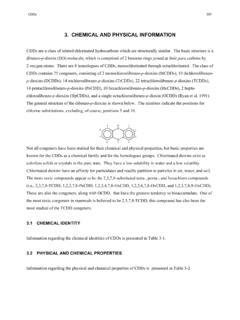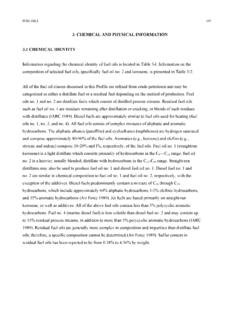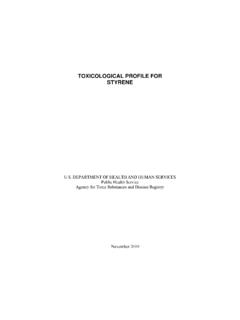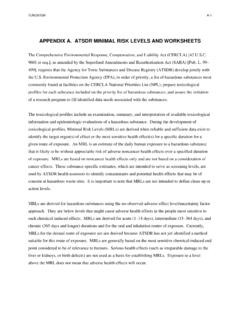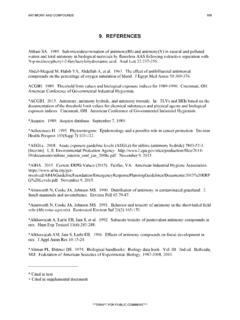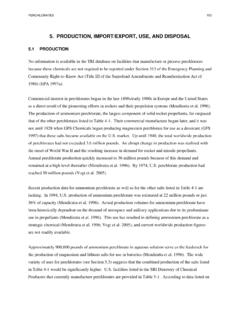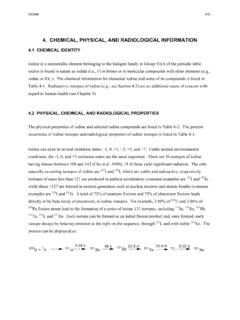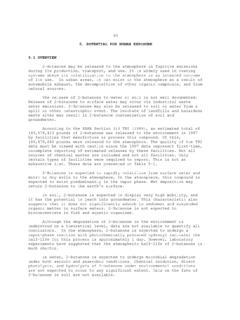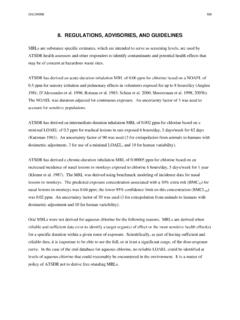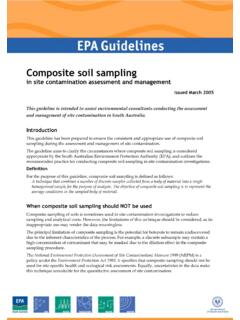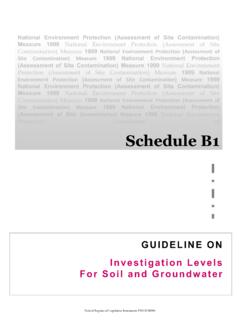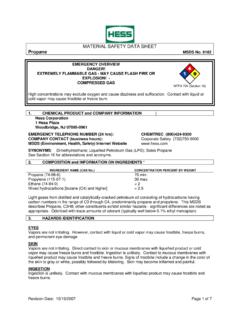Transcription of 2. OVERVIEW OF TOTAL PETROLEUM HYDROCARBONS
1 TOTAL PETROLEUM HYDROCARONS 9. 2. OVERVIEW OF TOTAL PETROLEUM HYDROCARBONS . This document presents information in a way that is more summary in nature than the usual comprehensive toxicological profile. TOTAL PETROLEUM HYDROCARBONS (TPH) is such a broad family of compounds that it would be a large undertaking to present comprehensive environmental, chemical/physical, and health information on all the individual chemical components or on all PETROLEUM products. This and subsequent chapters are designed to aid the reader in understanding what TPH is, what we know about it, the chance of significant exposure, and possible health consequences.
2 Appendices are provided that present more detailed information. DEFINITION OF TOTAL PETROLEUM HYDROCARBONS . TPH is defined as the measurable amount of PETROLEUM -based hydrocarbon in an environmental media. It is, thus, dependent on analysis of the medium in which it is found (Gustafson 1997). Since it is a measured, gross quantity without identification of its constituents, the TPH value still represents a mixture. Thus, TPH itself is not a direct indicator of risk to humans or to the environment. The TPH value can be a result from one of several analytical methods, some of which have been used for decades and others developed in the past several years.
3 Analytical methods are evolving in response to needs of the risk assessors. In keeping with these developments, definition of TPH by ATSDR is closely tied to analytical methods and their results. The ATSDR approach to assessing the public health implications of exposure to TPH is presented in Section There are several hundred individual hydrocarbon chemicals defined as PETROLEUM -based, with more than PETROLEUM components identified in Appendix D of this profile. Further, each PETROLEUM product has its own mix of constituents. One reason for this is that crude oil, itself, varies in its composition.
4 Some of this variation is reflected in the finished PETROLEUM product. The acronym PHC ( PETROLEUM HYDROCARBONS ) is widely used to refer to the hydrogen- and carbon-containing compounds originating from crude oil, but PHC should be distinguished from TPH, because TPH is specifically associated with environmental sampling and analytical results. PETROLEUM crude oils can be broadly divided into paraffinic, asphaltic, and mixed crude oils (WHO 1982). Paraffinic crude oils are composed of aliphatic HYDROCARBONS (paraffins), paraffin wax (longer chain TOTAL PETROLEUM HYDROCARONS 10.)
5 2. OVERVIEW OF TOTAL PETROLEUM HYDROCARBONS . aliphatics), and high grade oils. Naphtha is the lightest of the paraffin fraction, followed by kerosene fractions. Asphaltic crude oils contain larger concentrations of cycloaliphatics and high viscosity lubricating oils. PETROLEUM solvents are the product of crude oil distillation and are generally classified by boiling point ranges. Lubricants, greases, and waxes are high boiling point fractions of crude oils. The heaviest, solid fractions of crude oils are the residuals or bitumen.
6 Some products are highly predictable ( , jet fuels) with specific fractions of defined components; others, for example, automotive gasolines, contain broader ranges of hydrocarbon types and amounts. Table D- 1. in Appendix D provides a comprehensive list of PETROLEUM HYDROCARBONS . PETROLEUM products, themselves, are the source of the many components, but do not define what is TPH. They help define the potential HYDROCARBONS that become environmental contaminants, but any ultimate exposure is determined also by how the product changes with use, by the nature of the release, and by the hydrocarbon 's environmental fate.
7 When PETROLEUM products are released into the environment, changes occur that significantly affect their potential effects. Physical, chemical, and biological processes change the location and concentration of HYDROCARBONS at any particular site. PETROLEUM HYDROCARBONS are commonly found environmental contaminants, though they are not usually classified as hazardous wastes. Many PETROLEUM products are used in modern society, including those that are fundamental to our lives (i:e., transportation fuels, heating and power-generating fuels).
8 The volume of crude oil or PETROLEUM products that is used today dwarfs all other chemicals of environmental and health concern. Due to the numbers of facilities, individuals, and processes and the various ways the products are stored and handled, environmental contamination is potentially widespread. soil and groundwater PETROLEUM hydrocarbon contamination has long been of concern and has spurred various analytical and site remediation developments, , risk-based corrective actions (ASTM's Risk-Based Corrective Action [RBCA]), EPA and state government underground storage tank (UST).
9 Programs, British Columbia's Ministry of Environment's development of remediation criteria for PETROLEUM contamination (primarily environmental risks) (BC 1995), and the annual Amherst Massachusetts conference from which the TOTAL PETROLEUM hydrocarbon Criteria Working Group (TPHCWG) was formed. The TPHCWG is made up of industry, government, and academic scientists, working to develop a broad set of guidelines to be used by engineering and public health TOTAL PETROLEUM HYDROCARONS 11. 2. OVERVIEW OF TOTAL PETROLEUM HYDROCARBONS . professionals in decisions on PETROLEUM contaminated media.
10 In 1997 the criteria working group published a technical OVERVIEW of their risk management approach to TPH (TPHCWG 1997a), which represents the most comprehensive effort in this area to date. In 1997 the TPHCWG published two volumes, Selection of Representative TPH Fractions Based on Fate and Transport Considerations (Vol. 3) and Development of Fraction Specific Reference Doses (RfDs) and Reference Concentrations (RfCs) for TOTAL PETROLEUM HYDROCARBONS (TPH) ( ) (TPHCWG 1997b, 1997c). In 1998 the TPHCWG published Volume 1, Analysis of PETROLEUM HYDROCARBONS in Environmental Media (TPHCWG 1998a) and Volume 2, Composition of PETROLEUM Mixtures (TPHCWG 1998b).
